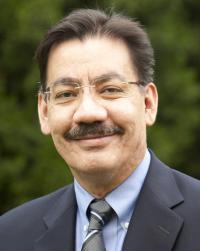José
López
M.D.

206-568-2244
Bloodworks NW
Research Institute
1551 Eastlake Ave. E Suite 100
Seattle, WA 98102
education, training, board certifications
- M.D., University of New Mexico
- Residency in Internal Medicine, University of Washington
- Fellowship in Hematology/Oncology, University of Washington
Clinical expertise
- Hemostatis and thrombosis
- Sickle cell anemia
- Idiopathic thrombocytopenic purpura
- thrombotic thrombocytopenic purpura
Affiliations
publications
research and/or clinical interests
Dr. Lopez's primary research focus delves into platelet adhesion and von Willebrand factor functions. For many years the laboratory has studied the basic mechanisms of platelet adhesion. Initially, these studies were aimed at the synthesis, assembly, posttranslational modifications and defining the ligand-binding sites of the receptor that mediates the first step of platelet adhesion, the glycoprotein (GP) Ib-IX-V complex. These studies are continuing, now focused on the association of the GP Ib-IX-V complex with membrane microdomains known as lipid rafts and downstream signaling after the complex has bound its primary adhesive ligand, von Willebrand factor (VWF), a multimeric polypeptide synthesized in endothelial cells and megakaryocytes.
The work also extends into the functions of VWF. Dr. López' laboratory has demonstrated that when endothelial cells are stimulated to release VWF-containing granules, the Weibel-Palade bodies, VWF forms extremely long strings on the endothelial surface, to which platelets rapidly attach. In the presence of plasma, the strings are rapidly cleaved by the action of the metalloprotease ADAMTS-13. In contrast, plasma from patients afflicted with the systemic microthrombotic disorder, thrombotic thrombocytopenic purpura (TTP), fails to cleave the strings, providing a mechanism for microvascular occlusions seen in the disorder. Because of their extraordinarily large size, newly released VWF is called ultra-large VWF, or ULVWF. We have also shown that ULVWF is not only enormous; it is also more adhesive at the single bond level. The molecular basis of this increased reactivity is a major topic of research in the laboratory.
Dr. López' lab also studies the interactions of platelets with endothelium and leukocytes. Recent research, including his, indicates that platelets play roles in inflammation that goes beyond their hemostatic role. He has shown, for example, that lowering the platelet count with anti-platelet antibodies markedly protects mice from the systemic inflammatory response that accompanies resuscitation from hemorrhagic shock by effects that include the diminution of neutrophil infiltration. He has begun to dissect the molecular basis of the effect by defining counter-receptors on platelets for neutrophil integrins. and found that leukocyte Mac-1 (aMb2) binds platelet GP Iba, the largest component of the GP Ib-IX-V complex and the polypeptide responsible for binding VWF. The interaction of GP Iba with Mac-1 is of particular interest, as he has recently shown that blocking it prevents restenosis after vessel injury and profoundly reduces inflammation after corneal injury. He is exploring the possibility of developing blocking agents to treat inflammatory disorders.
His lab is also exploring adhesive interactions in sickle cell vaso-occlusion, focused on the role of the sulfated glycolipids sulfatide as playing an important role in sickle cell vaso-occlusion. He has produced a single-chain variable fragment antibody that recognizes sulfatide and shown that erythrocytes from sickle cell patients express more of the lipid on their surfaces. Sickle and normal erythrocytes adhere to surfaces of VWF, thrombospondin-1, and laminin, with adhesion of sickle cells being more resistant to the effects of shear stress. This adhesion is blocked by the anti-sulfatide antibody and is reduced considerably in mice incapable of synthesizing sulfatide. As VWF is appears to be an important adhesive receptor for sickle cells, he examined whether the decreased activity of ADAMTS-13, which not only cleaves ULVWF but also process it to less adhesive forms, might predispose a patient to developing vaso-occlusion.
Dr. López also explores the role of platelet, leukocyte and endothelial microparticles in health and disease. One project in the laboratory concerns membrane blebs called microvesicles or microparticles and their roles in normal hemostasis, thrombosis, and acute inflammatory responses. His data indicate that microparticles play important roles in endotoxin-induced disseminated intravascular coagulation.



